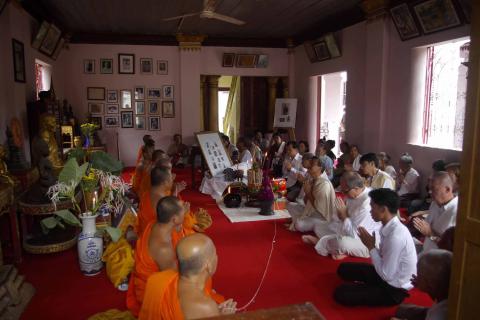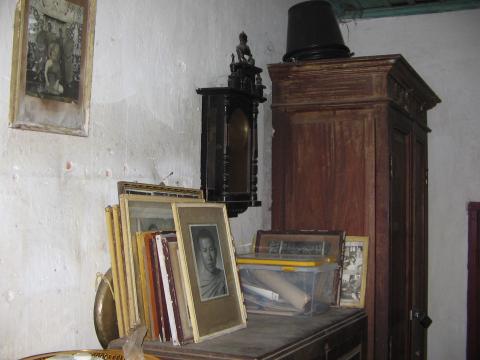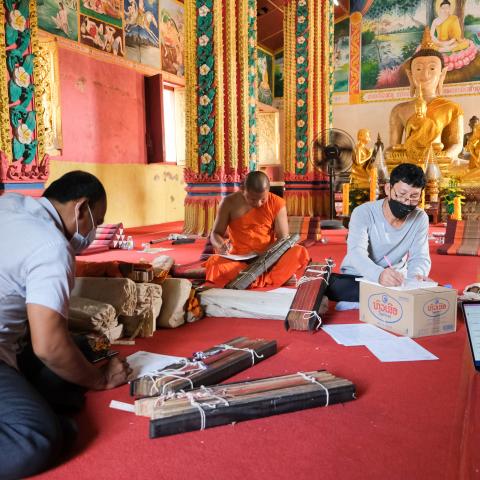
Aims and objectives
One of the 64 Buddhist monasteries of Luang Prabang, the former Royal City of Laos, harbours a unique collection of photographic documents that few people know about and that only one living person has ever seen entirely - the learned and highly respected monk who, for almost seventy years, has been collecting these photographs. The oldest documents go back to the times of early photography; the latest come up to our own days. The archive thus spans 100 years of photography of Theravada Buddhism, concentrating on monastic life, ceremonies and portraits of eminent monks and scholars.
Most of the monastic photographic collections established in South East Asia have been destroyed by a difficult climate, by neglect and by poverty, and, above all, the extraordinary political and social changes, war, civil war and revolution that affected the region during the 20 th century. The influx of tourism and the development of a capitalist market economy constitute a new threat today.
Right from the beginning, the support of a highly respected senior abbot, Phra Khamchanh Virachittathera, has been given to the project. He established the archive of Buddhist photography in his monastery. The archive is still hidden in cupboards covering the walls of his reception room and his Kuti.
The Venerable abbot turned 85 on October 2nd, 2005. He is the only person able to identify the images of the collection today. What will happen to the archive upon his death is not clear at all; traditionally, such photographs are distributed to the monk's followers, as a Dhamma gift, or the photographs might be cremated with the monk's body (they are considered carriers of Karmic energies of those portrayed). If the archive falls into the hands of non-Buddhists, neglect, mistreatment or dispersion are very likely.
Several factors contribute to the assumption that the archive contains unique and rare material:
- the unusual personal passion for photographic documents of the Venerable abbot;
- the importance of his monastery as a place of ordinations of members of the royal court;
- Luang Prabang's importance as a centre of Theravada pilgrimage, and its continuous connections with similar centres all over South East Asia;
- the fact that similar archives, if they existed at all, would not have benefited from the protection of one and the same monk for over 50 years
The pilot project aims to:
- acquire a complete overview over the material;
- identify each photographic document through interviews with the Venerable abbot;
- start to professionally scan and digitize each document as far as possible, following the technical requirements of the programme;
- assess the existence of any photographic material that might be stored in other monasteries of the city
The National Library of Laos will be the best local host institution in Laos for any copy material produced in the future, while the originals should remain in the possession of the monastery. It is part of the pilot project to assess the feasibility and conditions of a collaboration with the National Library as well as the evaluation of future preservation and storage conditions of the documents inside the monastery.
Outcomes
This pilot project was successful in surveying the archive of approximately 15,000 photographs and in establishing an overview of themes and subjects present in the archive.
Several hundred photographs were selected for scanning, in an attempt to represent the archive's main lines of interest of significant images. With the Venerable Abbot's help, about 80% of the scanned images were identified. The original photographs have been relocated into plastic boxes, respecting the order found at the beginning of examination.
The physical condition of the material varies greatly. Most photographs are black and white silver gelatine prints on barytic paper. There are also some early albumin prints, some cyanotypes and bromogravures, a few glass negatives and some early cellulose nitrate negatives. These negatives have been removed from the collection as they represent a serious fire hazard since they are auto-inflammable.
The project's aims were explained to both the monastic and lay communities. The Programme's rule that original photographs would not be removed from the monastery, whilst scans would be available for archiving and study at the British Library and the National Library of Laos in Vientiane, was met with gratefulness and acceptance.
Three other major monasteries have been researched: Vat Xiang Thong Volaviharn; Vat Pak Khan; and Vat Nong. Material different to that contained in the main archive has been found, though in significantly smaller numbers. The material of Vat Xiang Thong has been assembled and stored in a locked room in the monks' quarter. The material of Vat Nong is now kept in the Abbot's rooms. These albums contain what is left of the work of a monk photographer, Phra Oun Hüan, dating from 1950 to 1970.
At the end of the project, proposals were drawn up for a future major digitisation project - formally agreed by the Venerable Abbot during a ceremony in the presence of some of his disciples.
Full agreement was reached with the Library's Director General that the National Library of Laos would be the national archival partner, keeping a full digital copy of all the collections. It was learned that the photographic collections of both the National Library and the National Archive of Laos did not survive the revolution.





